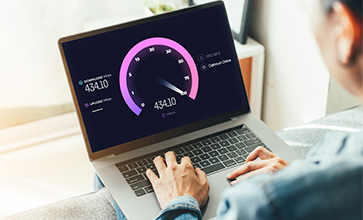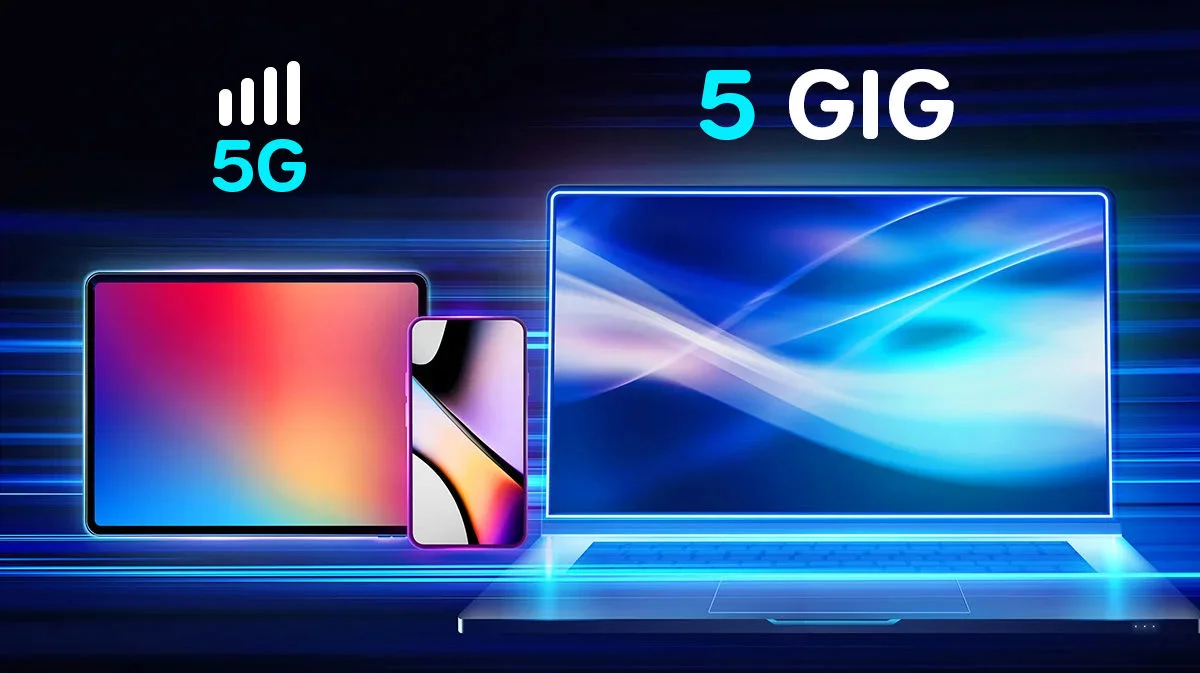Choosing the Right Internet Speed for Your Home
By: Vincent Totino
Read Time: 7 min.
December 11, 2025
Simply signing up for any Internet service does not guarantee the right speed. You might be settling for Internet speeds that barely keep up with today's demands or missing out on the seamless performance that higher-speed plans deliver.
Your download and upload speeds directly impact Internet performance, affecting everything from video streaming and online gaming to video conferencing and smart devices running on the same connection.
The Internet speed you need depends on how many devices are connected, what you use the Internet for, and whether you rely on Wi-Fi connections or a wired connection like an Ethernet cable.
Fiber Internet providers like Optimum offer the best upload speeds because fiber Internet delivers symmetrical speeds, meaning your download and upload speeds are the same. With Optimum Fiber, you get equally powerful upload and download capabilities for truly balanced performance.
This guide breaks down download and upload speeds and what's considered optimal bandwidth for a seamless Internet experience. Read on to discover how Optimum's higher-speed plans deliver the performance modern households deserve.

What Is My Download Speed?
What Is a Good Download Speed?
Download speed measures how quickly your Internet connection can receive data from the Internet. With today's bandwidth-intensive activities and multiple connected devices, 300 Mbps or higher is the ideal starting point for modern households. This ensures smooth performance even when multiple family members are streaming 4K content, gaming online, and working from home simultaneously.
Here's why 300 Mbps speeds and above deliver superior performance:
- For households with 3-5 devices and moderate usage: 300 Mbps provides comfortable headroom for concurrent activities such as video streaming, web browsing, and video calls without buffering or lag.
- For households with 5-7 devices and heavy usage: 500 Mbps delivers exceptional performance for 4K streaming on multiple screens, cloud gaming, large file transfers, and seamless smart home device connectivity.
- For households with 8+ devices, gamers, and remote workers: 1 Gbps and higher (1,000 Mbps – 8,000 Mbps) ensures future-proof performance with virtually unlimited capacity for all your connected devices, 8K streaming, VR gaming, and simultaneous high-bandwidth activities.
Here's a breakdown of how higher speeds enhance common activities:
Streaming Video
- 4K streaming on multiple devices simultaneously requires substantial bandwidth. With 300 Mbps or higher, your household can stream on 3-4 devices in 4K without any buffering.
- 500 Mbps easily supports 5-6 simultaneous 4K streams plus additional browsing and gaming.
Online Gaming:
- Competitive gaming benefits from speeds of 300 Mbps or higher, which provides low latency and fast download times for game updates and patches that can exceed 50-100 GB.
- With 500 Mbps to 1 Gbps, you can play games while others stream, ensuring no one's experience suffers.
Video Conferencing:
- HD video calls are flawless with 300 Mbps, even when multiple household members are on simultaneous calls.
- 500 Mbps or higher guarantees crystal-clear quality for professional meetings, even with screen sharing and multiple participants.
Downloading Large Files:
- With 300 Mbps, a 10 GB file downloads in under 5 minutes.
- At 1 Gbps, that same file downloads in just over 1 minute, making software updates, game downloads, and cloud backups virtually instantaneous.
Smart Home Devices:
- With dozens of smart devices becoming the norm, 300 Mbps provides the bandwidth these devices need without impacting your primary activities.
- 500 Mbps and higher ensures your smart home ecosystem operates flawlessly alongside entertainment and work demands.
To check your current Internet performance, run a speed test using Optimum's Internet speed test and see how upgrading to 300 Mbps or higher could transform your online experience.
What Is My Upload Speed?
What Is a Good Upload Speed?
Upload speed measures how fast your Internet connection can send data from your device to the Internet. A good and reliable upload speed is critical for video conferencing, live streaming, competitive online gaming, and uploading large files. For modern households, upload speeds of 20 Mbps or higher are recommended, with 50-100 Mbps being ideal for content creators and remote workers.
Here are specific recommendations:
- Video Conferencing: 20-50 Mbps upload ensures HD quality with no dropped connections, even with screen sharing and virtual backgrounds.
- Live Streaming: Content creators need 50-100 Mbps upload speeds for high-quality streaming platforms such as Twitch and YouTube.
- Cloud Backup & File Sharing: 50 Mbps or higher dramatically reduces backup times and makes sharing large files effortless.
- Competitive Gaming: 20-50 Mbps upload speeds provide the responsiveness competitive gamers demand.
Why Are Upload Speeds Typically Slower Than Download Speeds?
The main reason upload speeds are typically slower than download speeds is due to how most Internet service providers (ISPs) allocate Internet bandwidth. Most broadband connections, especially cable Internet and DSL, are designed to prioritize download bandwidth over upload bandwidth since most users historically spent more time streaming, browsing, and downloading content rather than uploading.
However, this paradigm is shifting. With remote work, video conferencing, content creation, and cloud storage becoming everyday activities, strong upload speeds are now essential. This is why Optimum's higher-tier plans and fiber options provide significantly enhanced upload capabilities.
For non-fiber plans, upload speeds are often a fraction of the download speed. However, Optimum's 300 Mbps and higher cable plans offer substantially better upload speeds compared to basic packages, typically providing 20-35 Mbps upload speeds that handle modern demands.
To maximize your upload speed:
- Upgrade to Optimum's 300 Mbps or higher plans for dramatically improved upload capabilities
- Consider Optimum Fiber up to 8 Gbps for truly symmetrical speeds where upload matches download
- Use wired Ethernet connections for activities requiring high upload speeds
- Ensure your router supports the latest Wi-Fi standards (Wi-Fi 6 or 6E)
Why Is Uploading Slower Than Downloading?
How to Troubleshoot Slow Download Speeds
If you're experiencing slow download speeds despite having a high-speed Internet connection, the issue may not be with your Internet provider but rather with your device, network setup, or external factors.
Follow these steps to troubleshoot slow download speeds:
- Run a speed testusing Optimum's Internet speed test tool to confirm your actual speeds versus your plan's advertised speeds.
- Check connected devicesto see if too many devices are consuming bandwidth simultaneously. With 300 Mbps or higher, this is rarely an issue.
- Restart your modem and router to refresh your connection and clear temporary network issues.
- Use a wired connectionby connecting directly via Ethernet to eliminate Wi-Fi interference factors.
- Update your router firmwareto ensure optimal performance and security.
- Check for background downloadson your devices that may be consuming bandwidth.
- Consider your planand whether it still meets your household's needs. If you're on a plan below 300 Mbps, upgrading can eliminate most speed-related frustrations.
Why Is My Download Speed So Slow When I Have Fast Internet?
Internet Speed Comparison
| Internet Type | Download Speed | Upload Speed | Best For |
|---|---|---|---|
| Fiber Internet | 500 Mbps–8 Gbps | 500 Mbps–8 Gbps | Large households, work-from-home professionals, content creators, and bandwidth-intensive activities |
| Cable Internet (Hybrid Fiber Coaxial HFC) | 300–2,000* Mbps | 20–200* Mbps | Modern households with streaming, gaming, and multiple devices |
| Satellite Internet | 25–100 Mbps | 3-45 Mbps | Rural areas with limited wired Internet access |
| 5G Home Internet | 90-425 Mbps | 10-55 Mbps | Rural areas with little to no Fiber Internet access |
*Optimum now offers 2,000 (2 Gig) download speed and 200 Mbps upload speed now available in some areas.
Upgrade to Optimum's High-Speed Plans
If your current Internet connection isn't delivering the performance your household needs, it's time to experience the difference that 300 Mbps and higher speeds make. Check out Optimum's fiber Internet plans to get reliable Internet service with superior speeds, robust upload capabilities, and low latency that keeps your entire household connected without compromise.
With Optimum's 300 Mbps, 500 Mbps, 1 Gig plans, along with our multi-gig fiber options, you'll never have to choose between who gets to stream, game, or work. Everyone gets the bandwidth they need when they need it.





